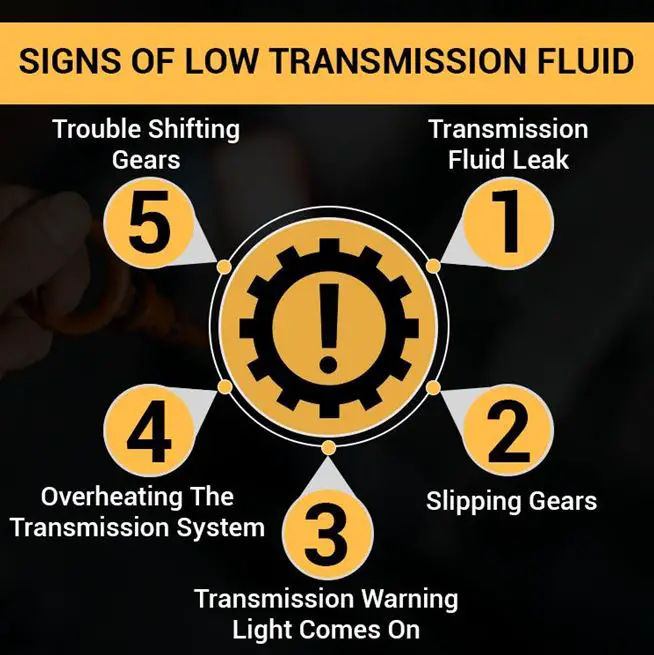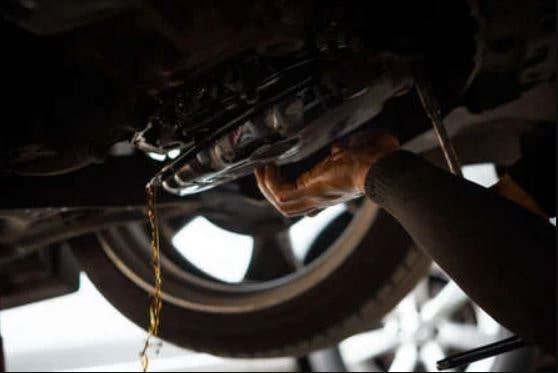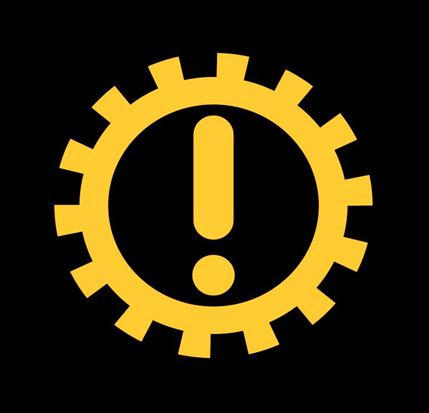In this article, you will learn what is transmission fluid? And 5 signs of low transmission fluid and their remedies are explained with pictures.
Signs of Low Transmission Fluid
Your vehicle will not function properly when your transmission fluid level is low. The fluid is responsible for the smooth running of the transmission system.
Delaying transmission fluid change puts your car’s transmission and its components at risk. And believe me, it isn’t going to cost you a little fortune to repair. The right step to take is to know how frequently you should change the transmission fluid according to your manufacturer’s suggestion and to do so.
This article will explain the signs of low transmission fluid as well as how to fix it. Continue reading to learn more.
Read Also: What are the Types of Turbochargers are Best? Pros & Cons
What Is Transmission Fluid
Transmission fluid, commonly known as hydraulic fluid, is used to lubricate the internal parts of a vehicle’s transmission for peak performance. Transmission fluid also cools transmission components, keeps your transmission shifting smoothly, and protects its internal parts.
The most important is that you should pick the right transmission fluid specified for your vehicle. Using the wrong type of transmission fluid can lead to severe damage. Visit Oils Advisor to select the right TF for your car.
Your vehicle may struggle to move without a normally functioning transmission. Fresh transmission fluid is bright or translucent red, however, it can also be blue. Transmission fluid is dyed red to distinguish it from other car fluids like engine oil or brake fluid.
Transmission fluid deteriorates from its natural reddish color to black as it ages. The smell of transmission fluid is typically odorless. It may also have a sweet odor. A burnt toast smell means it’s time to change your transmission fluid.
Signs Of Low Transmission Fluid
When your transmission fluid runs low, your vehicle’s overall performance suffers. It also exhibits various symptoms that can be attributed to a lack of transmission fluid. These warning signs should not be ignored. They should be addressed as soon as possible to avoid causing harm to your transmission system.
Following are the signs of low transmission fluid:
- Transmission fluid leak
- Slipping gears
- Transmission warning light comes ON
- Overheating the transmission system
- Trouble shifting gears

#1 Transmission Fluid Leak

A fluid leak is a common indicator of low transmission fluid. Transmission fluid is usually red or brown in appearance. They are quite easy to detect. You’ll notice a puddle or red to brown stains underneath your car.
Transmission fluid leaks are typically caused by a faulty seal or gasket, transmission lines, valves, or a crack in the transmission pan. If a minor fluid leak is neglected, it can result in possible transmission failure.
You should have your car examined by a transmission specialist as soon as you notice a transmission fluid leak. They can inspect the car to find the source of the fluid leak and then repair it.
#2 Slipping Gears

When the transmission is critically low on fluid, it will slip or not move at all.
Transmission slippage is another sign that the fluid is low. A lack of fluid in your transmission will result in overheating of the transmission’s internal parts. This condition will result in low hydraulic pressure in your transmission, which eventually causes it to slip out of gears.
To shift gears, the transmission relies on the hydraulic pressure provided by the transmission fluid. When the fluid is low, the engaged gear slips and you won’t be able to stay in the current gear that you have picked.
When this happens, you’ll notice that your car is having difficulty shifting from one gear to the next. Driving with a transmission system that isn’t working properly is dangerous and not advisable.
#3 Transmission Warning Light Comes ON

Another reliable sign of low transmission fluid is the transmission warning light. The warning light illuminates to alert you of a problem with the transmission. However, the transmission warning light is not found on all automobiles. Older vehicles, for instance, don’t have it.
A transmission warning light also signals other transmission-related issues such as overheating, fluid temperature, internal transmission failure, and so on.
The transmission is one of the expensive components of your automobile. If the transmission warning light illuminates your car’s dashboard, you should solve the issue as soon as possible.
#4 Overheating The Transmission System
Transmission fluid also aids in keeping the system at the proper operating temperature. Low transmission fluid does not offer adequate lubrication to the transmission system. The transmission may begin to overheat due to excessive friction between moving parts.
If the transmission temperature rises above 200℉, it will be hazardous to the system. If your vehicle overheats while driving, pull over quickly and wait for it to cool down.
Overheating is a serious problem, and you should get your transmission system checked as soon as possible. When the transmission overheats, it can cause a slew of other issues. If you continue to drive with this problem, the transmission will suffer catastrophic internal damage.
#5 Trouble Shifting Gears

Low fluid levels cause delays in changing between gears in a transmission. This is one of the most typical problems caused by low transmission fluid. Low transmission fluid means your gears aren’t getting the lubrication they require.
This will make shifting gears more difficult, and if not corrected, your transmission will be ruined. When shifting gears, you may also hear grinding or clattering sounds. As a result, the transmission’s overall performance will decrease noticeably.
Regular gear may be difficult to operate if you are driving a car with a manual transmission. It is also possible that these gears will become unresponsive. It is critical to change your transmission oil regularly to ensure easy gear shifting.
How To Fix
It is important to check the transmission fluid levels frequently. When you notice any of these signs, you should address the issue. Any additional delay could permanently harm your transmission. It will also be more expensive than if you had fixed it right away. A low transmission fluid level will require that you top it up.
Firstly, check your owner’s handbook for the manufacturer’s recommendations on the best transmission fluid to use for your vehicle.
Adding transmission fluid to vehicles without a dipstick is a task. This job will necessitate the use of some special tools. It will require you to raise the vehicle, drain the fluid then refill it. I recommend taking your vehicle to an auto repair shop or dealership.
For vehicles with a dipstick, you’d need a funnel, gloves, and a new transmission fluid. Park your vehicle on a level surface. Start your engine and keep it running. Open the hood and look for the transmission dipstick. Remove the dipstick and insert the funnel into the dipstick hole of the transmission. Slowly pour the new fluid into the funnel to avoid overfilling it. Run through all of the gears with the car idling. This is to allow the newly added fluid to circulate properly.
Check to see if the fluid level remains normal. If it is, you have completed your task. If it isn’t, you’ve got a leak someplace. Replace the dipstick and close the hood.
Examine the vehicle to determine the source of the leak. The best solution is to replace the defective engine components with new ones. The transmission fluid should then be topped up. If it’s something severe, take it to a skilled technician who will identify the problem and repair it.
Conclusion
Transmission fluid aids in the reduction of friction between the transmission components. The transmission fluid in your car runs low and must be changed regularly. Follow the suggested transmission change intervals in your owner’s handbook.
I hope you have a better understanding of the signs of low transmission fluid as a result of this post. When next you experience such symptoms, take your vehicle to a trusted mechanic for maintenance.
That’s all there is to know about the warning signs of low transmission fluid. If you have any issues or questions about this article, please leave them in the comments section. Please share this post with your friends if you find it helpful.
So now, I hope I’ve covered everything about “signs of low transmission fluid“. If you still have any doubts or questions on this topic, you can contact us or ask in the comments. If you like this article then please share it with your friends.
Want free PDFs sitting at home? Then subscribe to our newsletter.
Read more about car engine parts in our blog:
i love mechanic that is why i need more of the mechanical PDF book.
We have lots of articles on mechanic topics, so you can subscribe to our newsletter. We send free PDFs to our subscribers via email.
very good your online power point.i am have no money how can study
No need to worry friend, TheEngineersPost is a free learning platform for engineers.